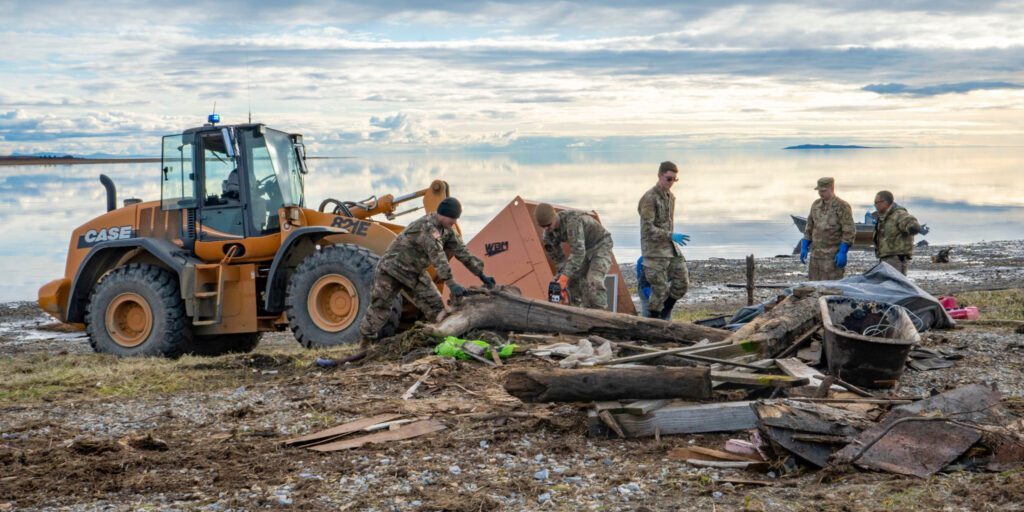In mid-September, communities all along the northwestern coast of Alaska, a distance equivalent to southern Georgia to New York City, suffered a historic storm. Typhoon Merbok brought with it a storm surge of more than 10 feet in Nome and the surrounding coastline, devastating several coastal communities.
In particular, the communities of Hooper Bay, Scammon Bay, Golovin, Newtok and Nome were hardest hit. According to a local damage assessment, more than a third of Golovin homes are severely damaged, even beyond repair. Ocean water and sewage contaminated every belonging in several homes. In Nome, a popular restaurant burned down, and the fire spread to damage a neighboring inn.

A few days after the flood waters had receded, Danielle Slingsby of Kawerak community members gathered to process what had happened on “Suwat,” a weekly show on current events.
Suwat guests emphasized the pain of losing a year’s worth of food and subsistence cabins and camps that took generations to build. Subsistence camps in rural Alaska represent more than a family’s primary source of food. Within those camps, Elders teach deep lessons and traditions. They even serve as a pressure release for families living in overcrowded homes. The sites are not recreational or luxury property, like family cabins elsewhere might be. They are vital for healthy and prosperous life in the region.

Nomeite Darlene Trigg described checking on her family’s cabin, which she had inherited from her late father.
“My earliest memories are in that building, and on that land. It’s a part of the foundation of who I am, it’s… built into my identity… It was home base… It was a place where everyone in our family was welcome, the door was there and open for us to be safe, and loved, and connected to the people who taught us our cultural values,” Trigg said. Her camp is one of many that were washed away in the typhoon. While grieving, she expressed immense gratitude that no lives were lost, for community support and for good leadership.
The group also remarked that while locals prepared for the storm, few were expecting this record level of destruction. When FEMA Administrator Deanne Criswell, Representative Mary Peltola, Senator Lisa Murkowski and Gov. Mike Dunleavy visited Nome and other places to see the damage for themselves, many community members asked them to take the consequences of climate change more seriously.
The rebuilding effort, while massive, is happening quickly. It has to, with snow falling early in Western Alaska. Homes, roads, camps, fuel storage sites, protective ocean berms and other infrastructure are not easily rebuilt when there are no roads. Plywood and other supplies must be ordered and flown into villages at exorbitant rates. Many have compared the storm impact we endured to living through Hurricane Sandy, or Hurricane Ian, but without roads to aid in recovery. Anything that isn’t fixed by winter will have to wait until next summer, or later.

Miraculously, the radio station, including its tower and transmitter, were both completely unharmed. Upon checking the transmitter site, staff members found that the flood had come close to wrecking hundreds of thousands of dollars worth of equipment, but stopped just a couple of feet in front of the building — leaving everything untouched.
Amid the loss, community members came together swiftly to help each other. The list of heroes is long.
In Hooper Bay, employees at the power company kept a bucket brigade of fuel going through the night to power the generator, so their neighbors’ freezers and homes would not lose power. Days after the storm, volunteers cleared Nome’s Front Street — with only the burned down building and a crane appearing as a reminder of the storm. Residents boated across Safety Sound to help retrieve drifting boats that their neighbors had lost. The City of Nome shared extra cots and blankets with Golovin, the community hit the hardest by the storm. Also in Golovin, a team of Iditarod mushers flew in to help with repairs, and one musher was badly injured in the process. In Unalakleet, a donated generator now pushes water through a cobbled-together pipe system to restore the community’s limited, main water supply.

By being good neighbors, contributing in donations, working hard and a committing to one another, Western Alaskans are finding the strength to rebuild.
Image at top: The Alaska National guard was deployed to help Golovin recover from storm damages. Photos courtesy of Alaska National Guard, used with permission (2022).






